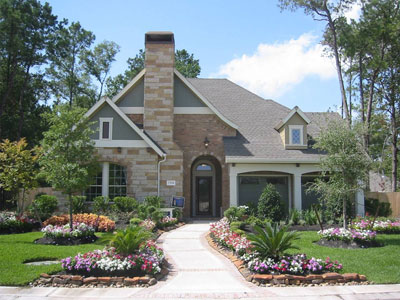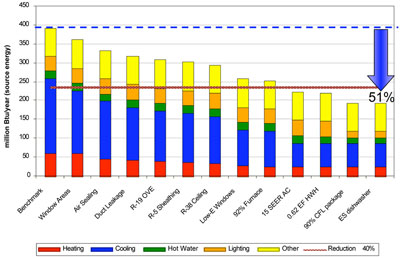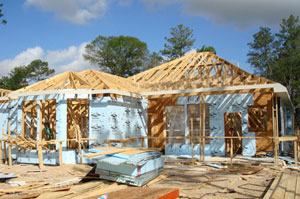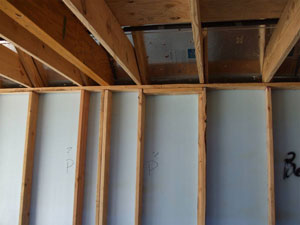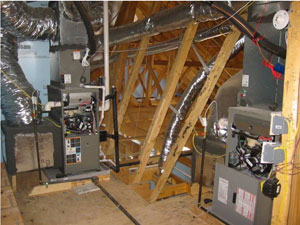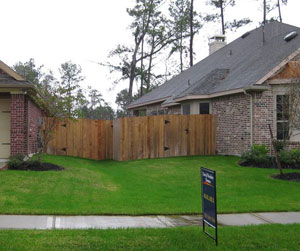This project includes two David Weekley Homes developments near Houston, Texas: Eagle Springs and Waterhaven. These two developments are located in Humble and Atascocita, Texas and consist of one- or two-story single-family houses between 1800 and 3500 square feet and three to six bedrooms. The project is located in DOE climate zone 2A, which is a hot-humid climate. When built-out, Eagle Springs will contain 36 houses, and Waterhaven will contain 112 houses.
David Weekley Homes (DWH) has many developments in the Houston area; however the Eagle Springs and Waterhaven developments are intended to be a test of the technologies and construction techniques required for high performance houses. In many of DWH’s developments in Houston, DWH works with the Environments for Living (EFL) program by Masco Corporation to provide energy and comfort guarantees to the homebuyers. In these two communities, DWH is building houses to the EFL’s highest level of efficiency, the Diamond level. In addition, DWH is adding insulating sheathing to the walls for additional insulating value.
These houses feature advanced framing, which includes 2x6 exterior walls and 2x4 interior (partition) walls, both spaced at 24” on center instead of the standard 16” on center. All joists and rafters are stack-framed, meaning that single top-plates can be used, and headers above doors and windows are eliminated where the wall is not load-bearing. All of this results in less thermal bridging and an enclosure that reduces the amount of heat flowing through the wall.
BSC has been on site for several frame walks during construction to examine how the integration of the building systems was working in a production setting. David Weekley has been very successful in integrating advanced framing and insulating sheathing into the design and construction of homes in these communities.
DWH personnel are pleased with both the advanced framing and insulating sheathing technologies. DWH has documented a 5-10% reduction in both board-feet and cost of framing each house due to advanced framing. Additionally Mike Funk, the Houston-area quality coach for DWH, has remarked that the combination of insulating sheathing, cellulose insulation, high-quality windows, and air sealing techniques makes the homes significantly quieter than their competitors’ homes in the area, which is important because of a nearby airport.
Project Team: David Weekley Homes, Building Science Corporation
Address: Humble, Texas and Atascocita, Texas
Description: One- and two-story single family homes; 1,800 ft2 to 3,500 ft2; 3 to 6 bedrooms, 2 to 4 bathrooms
Completion Date: Under construction; approximately 25 houses complete as of January 2009; complete build-out will be 169 houses
Estimated Annual Energy Savings: $1,300 to $2,500 per year; 40-to-45% projected source energy savings relative to the Building America Benchmark
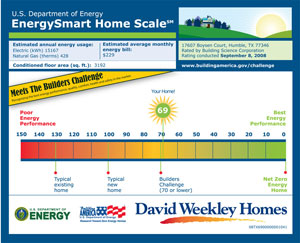
Builders Challenge Certificate
Marketability
Given the current housing slow-down, these houses are selling well. The energy efficiency features, backed up by the energy guarantee program, are an aspect that helps close the deal for many customers who are considering houses built by DWH and other builders in the area.
The advanced framing technology in particular is working out very well for DWH. The slow-down in the housing market means that subcontractors are willing to take some time to learn new techniques, where they previously would have gone to other standard framing jobs. Once the subcontractors have learned the new techniques, advanced framing saves 5-10% of board-footage of framing, 5-10% of the cost of framing materials, and about 30% in number of framing pieces. The reduction in number of framing pieces should result in a reduction in the labor needed to frame the house, but the magnitude of this savings has not yet been quantified. DWH is so pleased with the results of advanced framing that it is planning to expand the practice to other developments in Houston, and to try it in select developments in Dallas, Austin, and San Antonio as well.
Enclosure Design
Roof: Vented hip roofs with asphalt shingles
Framing: OVE 2x6 wood frame walls
Air Sealing: Expanding foam was used to seal between the sill plate and the slab; draftstopping in building chases and behind bathtubs and showers; enclosure penetrations sealed with expanding foam; drywall caulked at all openings, wall corners, and top and bottom plates.
Roof Insulation: R-38 blown cellulose at the ceiling plane
Wall Insulation: R-25; R-20 damp-sprayed cellulose in the 2x6 wall cavity plus 1” R-5 XPS
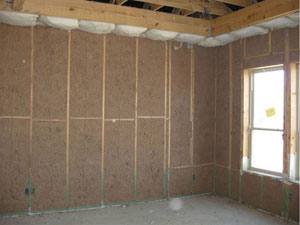
Damp-sprayed cellulose cavity insulation
Drainage Plane: XPS insulating sheathing; all horizontal and vertical joints taped with sheathing tape; windows are pan-flashed to the exterior of XPS sheathing; all roof-to-wall transitions have flashing and kick-out flashings.
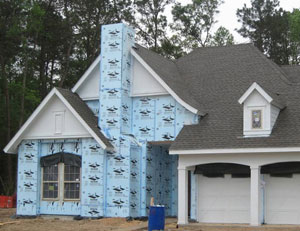
Insulating sheathing with joints taped
Foundation: 4”-thick post-tensioned monolithic slab with turned-down edges poured over 6-mil polyethylene as a capillary break; slab edge insulation was not used due to termite risk.
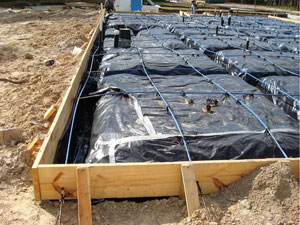
Polyethylene as capillary break
Window Specifications: Double-pane Low-E; U=0.34, SHGC=0.34
Infiltration: 0.25 in2 leakage area per 100 ft2 envelope
Features: Mature trees were left in the development where possible.
Climate Specific: In a hot-humid climate, a high level of comfort at a low cost requires, (in this order of priority):
- glazing with low solar heat gain;
- air sealing;
- opaque areas with moderately high thermal insulation; and
- glazing with thermal resistance at least high enough to avoid wintertime condensation.
Mechanical Design
HERS Index Score: 63 to 70 depending on model
Heating: 94% AFUE natural gas furnace
Cooling: 15 SEER air conditioner in vented attic
Ventilation: Lennox VCS central-fan-integrated supply (CFIS) with fan cycling and motorized damper to prevent over-ventilation.
Return Pathways: Jump ducts at all bedrooms
Ducts: R-6 flex ducts in vented attic
DHW: 0.62 EF natural gas hot water heater in vented attic
Appliances: Energy Star dishwasher, refrigerator and range
Water Management
Landscape Plan: Positive drainage away from foundation provided via sloping of grade around entire perimeter of foundation (front, back and sides).
Quality Assurance & Quality Control
Design follows BSC Building America Performance Criteria (QA)
- ACCA Manual J analysis ensures right-sized mechanical systems (QA)
- A durability checklist (QC) was created to address areas where quality of work has an effect on the energy performance, indoor air quality and durability of the house. Team members then verified these items in the field to ensure they were installed or constructed as required. Here are some examples from the checklist that apply:
- Air Barrier System - Interior air barrier composed of gypsum board connected via sealant to framing at perimeter and penetrations; also sealed at rim joists and ceiling-to-wall interface. Additional air barrier resistance provided by taped joints on exterior insulating sheathing layer.
- Solar-Driven Vapor – Movement of vapor from brick to interior is controlled via a 1” cavity between brick and sheathing, with vents at top and bottom of the wall. Inward vapor diffusion is also controlled by the semi-permeable insulating sheathing.
Systems Testing
Enclosure air tightness and duct air tightness are tested on every house as part of the Masco EFL program. BSC also performs QA tests on a subset of the homes periodically, to ensure consistency.
Lessons Learned & Future Projects These houses have very complex geometries on both walls and ceilings. In certain places better details would have prevented excess work and waste on the part of the subcontractor, such as on the front elevation of certain houses where a double-wall is built for architectural effect; or in closets that have 8’ ceiling heights surrounded by rooms with 9’ or 10’ ceiling heights. Technology Gaps & Barriers The majority of the energy consumption in these houses is due to occupant-controlled miscellaneous electric loads, which we currently have few tools to address. |

